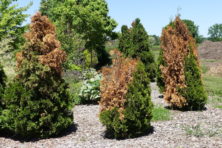Honey Badgers and Cancer-causing Genes
- Share
- Tweet
- Pin
- Share
• Indonesia not only has one of the world’s largest tropical forests, it is also one of the world’s top emitters of carbon pollution – mostly due to logging and converting this forestland to agriculture. Forests are major repositories of carbon, which is locked up in the structure of trees and which increases as the leaves of trees engage in photosynthesis and consume carbon dioxide and release oxygen. Burning all or part of the tree releases carbon dioxide. An agreement was reached between Indonesia and the U.S. to implement a program of sustainable logging. Estimates indicate that sustainable methods can reduce the damage to forests by up to 40 percent without decreasing the amount of timber taken to market. (Nature Conservancy, No. 1, 2012)
• According to the Guinness Book of World Records, the Honey Badger of Africa is the “most fearless animal in the world.” Pound for pound these South African mammals are among the most aggressive known and qualify as one of the “pit bulls” of land animals. Honey Badgers weigh 25 to 35 pounds, look a little bit like a long-legged skunk, and have thick skin. When agitated, they release a skunk-like odor and emit a “rattling” vocalization.
How fearless are they? They are reported to regularly chase lions and leopards away from their kills so that they can dine on the prey’s carcass. A hyena will run from one of these fierce little animals. Although these carnivores sometimes eat fruits and vegetables, they much prefer raw meat. The thing they most enjoy eating is honey, and they will dig into a hive and ignore thousands of stings to satisfy their sweet tooth. They also enjoy eating snakes, and they seem immune to snake venom. If bitten by a cobra after attacking it, all the venom does is make the Honey Badger drop off to sleep for a few minutes, after which it awakes and polishes off its meal of cobra. (www.honeybadger.com; http://www.huffingtonpost.com/honey-badger-don’t-care)
• All humans carry three potential cancer-causing genes in their DNA, but normally they are blocked or “turned off.” 1) All our cells carry genes called “oncogenes” or “proto-oncogenes” that, when mutated, give rise to cancer. This means that any of our cells can potentially give rise to cancer. 2) Our cells also carry genes called “tumor suppressor genes” that, when functioning properly, code for proteins that prevent unwanted cell division. When a tumor suppressor gene mutates, its loss may result in the cell dividing in an uncontrolled manner. 3) The third kind of genes that can mutate to cause cancer are called “DNA repair genes.” When cells divide to replace themselves normally (e.g., skin or gut cells), repair genes seek out mistakes in DNA replication and repair them, so they have the correct sequence of genes.
Usually, cancer occurs when at least two of the above kinds of mutations occur. As long as the code sequence in our DNA remains constant (i.e., does not mutate), we can live without cancer. However, as we age, the frequency of mutations in the aforementioned genes increases. It may be that this is one of nature’s ways of controlling population growth. (www.cancer.stanford.edu/information/genetics)


